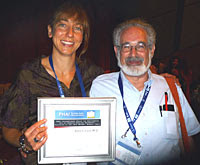It is a myth that high duties on tobacco lead to increased smuggling
It would be an insult to your intelligence, dear reader, if I explained why Arnott is talking rubbish. It is Tim Worstall's unreconstructed view that Ms Arnott should shut up and put the kettle on. I also recommend reading the disparaging comments beneath the article itself.
But all you really have to do is take a look at some of the stories reported on ASH's own website in recent weeks:
Two million illegal cigarettes seized in East Lancashire in two months
More than two million illegal cigarettes have been seized in the past two months in East Lancashire. Health chiefs disclosed the figure as they drew up a plan to reduce the harm that smoking and illicit tobacco has on the lives of people in the area. The tobacco, which is illegal because it has either been smuggled into the country or is counterfeit, is thought to be responsible for four times as many deaths as drugs.
Cigarettes seized in tobacco smuggling crackdown in Burton-on-Trent
More than 13,000 cigarettes were recovered from three shops by officers from HM Revenue and Customs (HMRC) in Burton-on-Trent, Staffordshire. Keith Morgan, Specialist Investigation Detection Manager for HMRC, said: “The people who sell these cigarettes are not concerned about where or how they are produced, or even who buys them, including young children and teenagers."
Warnings over sales of illegal cigarettes in South West
147 million packets of illegal cigarettes are smuggled into the South West each year, with an estimated street value of more than £104 million.
Smuggled cigarettes aimed at children
Trading standards officials in the North East are urging the public for help in stopping illegal tobacco after more than 600,000 packets of smuggled cigarettes were seized in the region. An appeal last year led to a surge in public tipoff’s about illegal cigarettes.
Richard Ferry, of the North-East Trading Standards Association, described the response as excellent and urged people to continue providing vital information. Ailsa Rutter, director of anti-smoking organisation Fresh, said: “The sellers have no morals. They will even sell single cigarettes called ‘lucies’ to children.”
Bootleg Russian cigarettes lined with Chinese asbestos
Smokers have been warned that some black market Russian cigarettes contain asbestos. Trading standards officials have revealed that many of the Jin Ling cigarettes contain industrial chemicals and asbestos-lined Chinese plasterboard. They come in yellow packs with the words Jin Ling and USA emblazoned across the front.
The brand has been described by the World Health Organization as ‘the most disturbing new development in the illegal tobacco trade anywhere in the world’.
Treasury counts cost of illicit tobacco smuggling
The sale of illicit and counterfeit cigarettes is estimated to cost the Treasury the equivalent of £10m a day in lost tax revenues. But it is not just government's coffers that are affected, small retailers such as newsagents are too.
Debbie Corris runs a tobacconists in Whitstable, and claims that cigarette smuggling has been hurting her business.
Officers seize 250,000 cigarettes at Newcastle airport
UK Border Agency officers at Newcastle Airport have intercepted more than a quarter of a million cigarettes that were being smuggled into the region.
South Yorkshire: Jail terms for cigarette smugglers
Four South Yorkshire crooks have been jailed for their part in a smuggling ring which helped the Italian Mafia flood Britain with black market cigarettes - while another escaped immediate custody.
Scotland: BBC exposes tobacco crime gangs in Scotland
A BBC investigation is set to expose the organised crime groups controlling Scotland's illegal tobacco trade. A BBC Scotland undercover team secretly filmed the supply chain. The illegal trade is estimated to cost the Treasury billions of pounds in lost taxes.
Northern Ireland: Customs seize 185,000 cigarettes
Ten kilograms of hand rolling tobacco and 185,000 counterfeit cigarettes have been seized in west Belfast. Two men from Belfast were arrested and cash and business records were also seized.
Birkenhead shopkeeper masterminded tobacco-packing scam
A shopkeeper who owned three stores in Birkenhead masterminded a huge tobacco-packaging scam to sell thousands of illegal cigarettes. HM Revenue and Customs (HMRC) raided his stores and seized £105,000 in cash.
Does Arnott really believe that there is no connection between sky-high tobacco taxes and the growth of a vast smuggling and counterfeiting industry which didn't exist until a few years ago? Since it is hard to believe that anyone could be so dense, I have to conclude—once again— that she is a liar.













